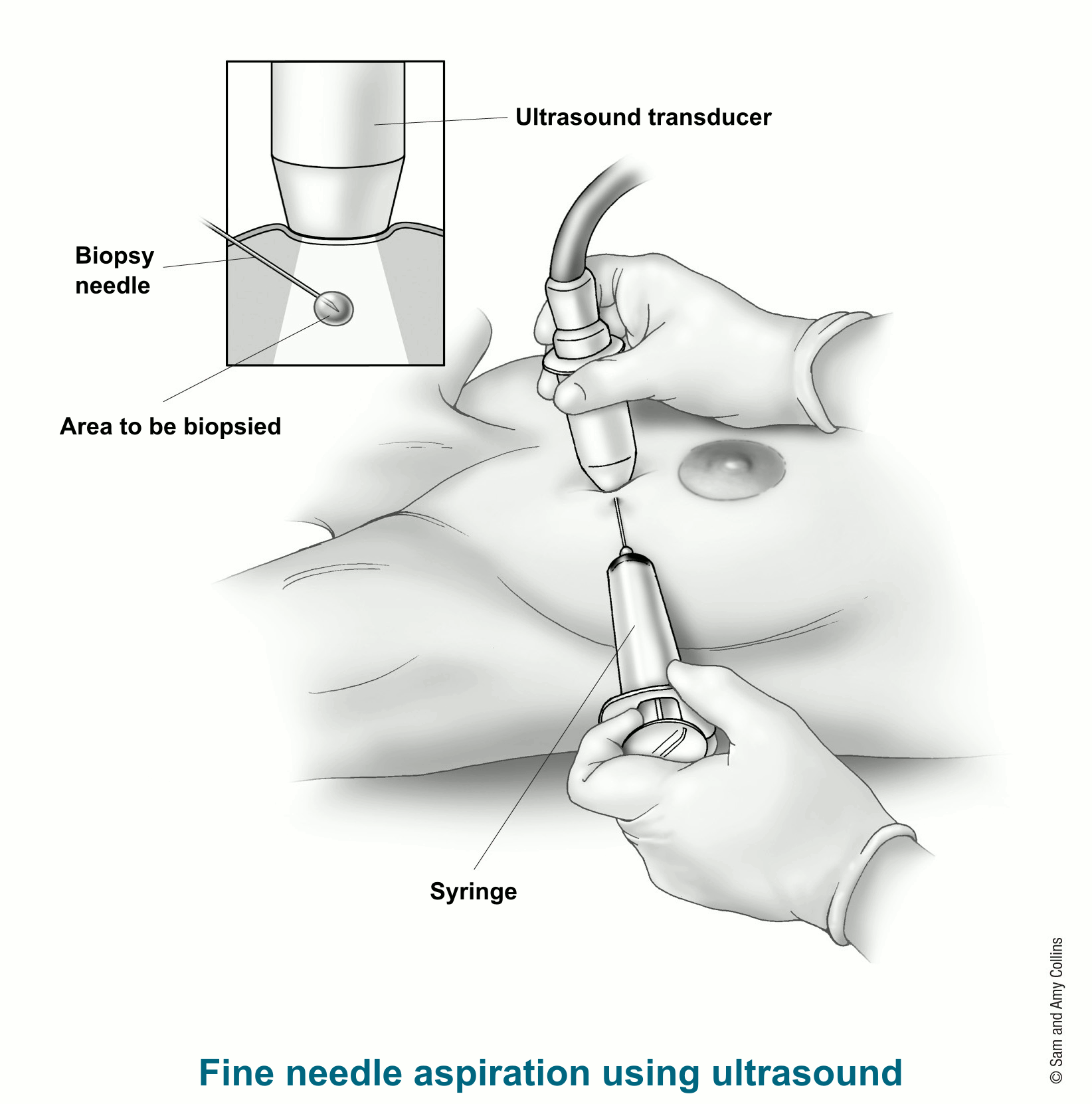Your gift is 100% tax deductible
Fine Needle Aspiration (FNA) of the Breast
During a fine needle aspiration (FNA), a small amount of breast tissue or fluid is removed from a suspicious area with a thin, hollow needle and checked for cancer cells. This type of biopsy is sometimes an option if other tests show you might have breast cancer (although a core needle biopsy is often preferred). lt might also be used in other situations.
What is an FNA of the breast?
In an FNA, the doctor uses a very thin, hollow needle attached to a syringe to withdraw (aspirate) a small amount of breast tissue or fluid from a suspicious area.
FNA is most often done if the suspicious area is likely to be a fluid-filled sac (a cyst). By removing fluid, the FNA can often help relieve pain from the cyst. FNA can also be helpful if the doctor is unsure if an area seen on an imaging test is a small cyst or a solid mass.
If the area to be biopsied can be felt, the needle can be guided into it while the doctor is feeling it.

If the lump can't be felt easily, the doctor might watch the needle on an ultrasound screen as it moves toward and into the area. This is called an ultrasound-guided FNA.
If an FNA is done to test a suspicious area in the breast, the sample is then checked for cancer cells. One drawback of FNA is that it only removes a small amount of tissue and cells, so the sample usually needs to be checked right away under a microscope to make sure more samples don’t need to be taken.
What should you expect if you have an FNA?
During an FNA
An FNA is an outpatient procedure most often done in the doctor’s office. Your doctor might use a numbing medicine (called a local anesthetic), but it's not needed in all cases. This is because the needle used for the biopsy is so thin that getting an anesthetic might hurt more than the biopsy itself.
You’ll lie on your back for the FNA, and you will have to be still while it’s being done.
If ultrasound is used, you may feel some pressure from the ultrasound wand and as the needle is put in. Once the needle is in the right place, the doctor will use the syringe to pull out a small amount of tissue and/or fluid. This might be repeated a few times. Once the procedure is done, the area is covered with a sterile dressing or bandage.
Getting each biopsy sample usually takes about 15 seconds. The entire procedure from start to finish generally takes around 20 to 30 minutes if ultrasound is used.
After an FNA
Your doctor or nurse will tell you how to care for the area where the biopsy was done and what you can and can’t do while it heals. You might be told to limit strenuous activity for a day or so, but you should be able to go back to your usual activities after that.
Biopsies can sometimes cause bleeding, bruising, or swelling. This can make it seem like a breast lump is larger after the biopsy. Most often, this is nothing to worry about, and the bruising and swelling will go away over time. Your doctor or nurse will give you instructions on what to watch for and when you should call the office.
What does an FNA show?
A doctor called a pathologist will look at the biopsy tissue or fluid to find out if there are cancer cells in it.
The main advantages of FNA are that it is fairly quick, it often doesn't require anesthesia, and the skin doesn’t have to be cut, so no stitches are needed and there is usually no scar. Also, in some cases it’s possible to get the results the same day.
However, an FNA can sometimes miss a cancer if the needle does not go into the cancer cells, or if it doesn't remove enough cells. Even if an FNA does find cancer, it might not remove enough cancer cells to do some of the other lab tests that are needed.
If the results of the FNA biopsy do not give a clear diagnosis, or if your doctor still has concerns, you might need a more extensive type of biopsy, such as a core needle biopsy or a surgical (open) biopsy.
- Written by
- References

The American Cancer Society medical and editorial content team
Our team is made up of doctors and oncology certified nurses with deep knowledge of cancer care as well as editors and translators with extensive experience in medical writing.
Joe BN, Esserman LJ. Breast Biopsy. 2021. UpToDate. Accessed at www.uptodate.com/contents/breast-biopsy on October 14, 2021.
Radiological Society of North America. Ultrasound-Guided Breast Biopsy. 2021. Accessed at https://www.radiologyinfo.org/en/info/breastbius on October 14, 2021.
Last Revised: January 14, 2022
American Cancer Society medical information is copyrighted material. For reprint requests, please see our Content Usage Policy.
American Cancer Society Emails
Sign up to stay up-to-date with news, valuable information, and ways to get involved with the American Cancer Society.



